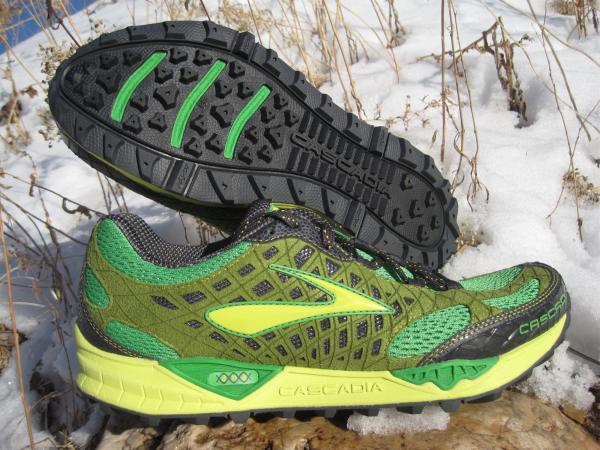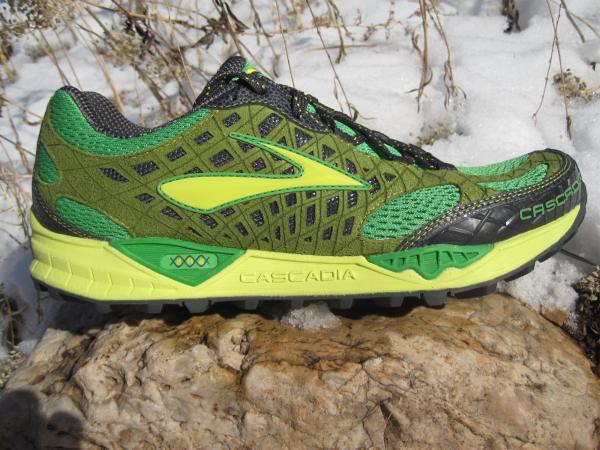Check out the most recent Cascadia in our Brooks Cascadia 19 review.
More Trail Running Shoe Options
To find more options for trail running shoes, check out our Best Trail Running Shoes article.
Brooks Cascadia 7 Review
It’s been a long, hard year for me. I received the Brooks Cascadia 6 last autumn, logged many a late winter and spring trail mile in them, but couldn’t favorably review them. Why not, if I managed to run so many miles in them? Because they didn’t live up to the trail shoe perfection I’d previously found in the Cascadia 4. How relieved was I went it only took one run in the Brooks Cascadia 7 for me to know that the Cascadia was back and better than ever
Seriously, it’d be a crime to call this a hybrid shoe. It’s all all-purpose running shoe. I logged my first run in the Cascadia 7s in the toughest circumstance I could – I hadn’t had a descent run in over two weeks. I threw these on and easily climbed the snow-covered trail behind my house. A minute later I was cruising the half mile of pavement to singletrack and loving it. When you run in any Cascadia, you know you’re running in a shoe made by a company that’s sold tens of millions of running shoes. The roll and feel of the Cascadia 7 is best tested on pavement and these masterpieces roll more beautifully than a 16 pound ball in a Big Lebowski dream sequence.
On the trails, the Cascadia 7 are even more in their element. These are the kind of shoes for the 99%… of trail runners (or at least those trail runners who still like substantial shoes). I remember running the Leadville 100 in 2009 in the Cascadia 4 and never having to worry about the finer points of foot placement. Heading out in the Cascadia 7, I felt the very same way. These are shoes you can put on and forget about as well as forget about the trail at the same time. Let’s get to the how.
Midsole
First off, there’s plenty of protection here. While not bombproof like the Montrail Hardrocks of yore, you can run moderately rocky trails not having to worry a bit about rocks other than avoiding tripping. Maybe you’d want a more significant rockplate for a day of running the rock gardens of the Massanutten 100, but these will do the trick for nearly everything else.
The same applies when bringing the Cascadia 7 onto smooth-faced hard surfaces such as slickrock… as well as pavement and concrete. The cushioning in the form of BioMoGo EVA is plush, but never too much. It’s the bowl of porridge you want to eat seconds of because it’s just right. I don’t know or care what exactly BioMoGo is so long as it’s comfy on both road and trail, which it is.
Outsole
The outsole is a generalist outsole that’s plenty smooth on the roads and offers sufficient traction for a non-mud-specific trail shoe. In my own testing, it gave plenty of traction on mud alongside recent snow melt as well as on packed sugary snow up to a couple inches deep. It didn’t provide much traction in the occasional mountain bike wallows with inch deep mud. In my mind that’s acceptable, as no shoe outside the realm of specialists shoes like the Salomon Speedcross, La Sportiva Crosslite, or Inov-8’s grippier models would have done any better.
This result is an improvement. There were two major design changes that had negative repercussions going from the Cascadia 5 to the 6. The first was the change from the shoe’s traditional triangular-lugged outsoles to a circular saw lugs in the central forefoot and heel-strike areas. Aside from reduced traction, others complained of reduced useful lifespan of these lugs. Well, Brooks has reversed course and returned triangular lugs to the core of its outsole.
Upper
I mentioned that, in my opinion, Brooks made two backward steps between the Cascadia 5 and 6, the second of which was creating what some described as a “sloppy” or “loosey goosey” upper. I felt that issue immediately, but it took me a few runs to figure out the cause – the second and third uppermost medial (instep-side) eyelets were “floating,” meaning that they were attached to the rest of the upper with an elastic band. This was a well-intended change meant to reduce discomfort atop the foot during runs with a ton of descent. It did that, but at the cost of feeling insecure when making steep or technical descents. The upper on the Cascadia 6 was great otherwise, which is why I ran in it a ton.
 Onward to the Cascadia 7 and the glorious removal of the floating eyelets! Seriously, I see many dozens of trail shoes a year and there’s never been such a small year-over-year modification to a trail model that’s made me happier. We are back to a secure, breathable, and all-around wonderful Cascadia upper.
Onward to the Cascadia 7 and the glorious removal of the floating eyelets! Seriously, I see many dozens of trail shoes a year and there’s never been such a small year-over-year modification to a trail model that’s made me happier. We are back to a secure, breathable, and all-around wonderful Cascadia upper.
While the Brooks design team was at it, they made a few improvements… and they’re actually improvements this time. To begin, they doubled the extent of the mid-foot overlay, moving it back to the middle of the ankle and forward to nearly the ball of the foot. This further enhances the Cascadia 7’s improved midfoot lockdown.
There’s also a nice asymmetric lacing (right) that should help reduce the top-of-foot pain the previous model’s floating eyelets were supposed to address.
Next, it seems to me that the microfiber overlay material is slightly thinner and, therefore, slightly less rigid in the 7 as opposed to the 6, which should slightly reduce the possibility of localized irritation at the edge of those overlays
Finally, Brooks has moved the superfluous heel pull. Does anyone every use those and, if not, can trail shoemakers keep sending them the way of the dinosaur?
Conclusion
This is great all-around shoe for trail runners. It is not a minimalist shoe nor does it try to be one. My US men’s 9 weighed in a hair under 12 ounces (11.93 oz/338 g) just like the Cascadia 6 (11.97 oz/339 g) and there’s a standard heel-to-drop. You know what, that suits me just fine! Sure, I’d prefer the Cascadia to weigh in at 10 or 11 ounces, but this is a shoe that does everything I want it to do right out of the box. It’s shoe that I could wear for every single run until they meet their end the better part of a 1,000 miles down the trail (and/or road). You can head out in your own pair of Brooks Cascadia 7 ($110) starting February 1, 2012.
Ps. The only change I’d like to see in the Cascadia at this point is a slightly wider toebox. With Drymax Max Pro socks (my running socks of choice), it’s a bit snug.
Call for Comments
- Are you a Cascadia fan and, if so, which was your first version of the Cascadia?
- Anyone else excited about a shoe that can meet so many runnerly needs?
- Any features that you’re psyched to see in the Cascadia 7?



